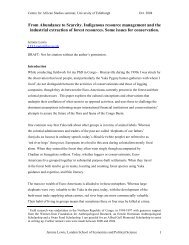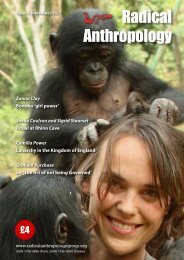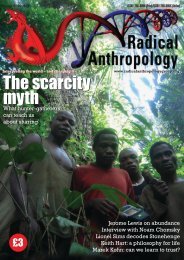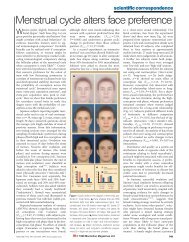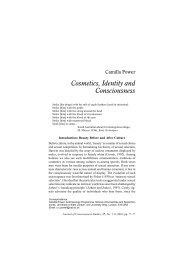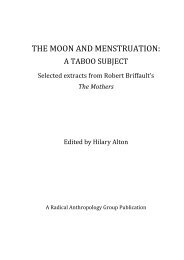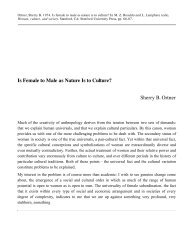Language and life history: A new perspective on the development ...
Language and life history: A new perspective on the development ...
Language and life history: A new perspective on the development ...
- No tags were found...
Create successful ePaper yourself
Turn your PDF publications into a flip-book with our unique Google optimized e-Paper software.
Locke & Bogin: <str<strong>on</strong>g>Language</str<strong>on</strong>g> <str<strong>on</strong>g>and</str<strong>on</strong>g> <str<strong>on</strong>g>life</str<strong>on</strong>g> <str<strong>on</strong>g>history</str<strong>on</strong>g>those children who experience it, but <strong>the</strong> rate of growthdeclines even in children without a detectable spurt. Thecause of this decrease in growth rate is unknown, butJans<strong>on</strong> <str<strong>on</strong>g>and</str<strong>on</strong>g> van Schaik (1993) have proposed severalbenefits. The first is that it provides additi<strong>on</strong>al time for<strong>the</strong> brain growth <str<strong>on</strong>g>and</str<strong>on</strong>g> learning required for reproductivesuccess in various species of social mammals. Social carnivores,elephants, <str<strong>on</strong>g>and</str<strong>on</strong>g> primates must all learn how to livewithin <strong>the</strong> social hierarchy of <strong>the</strong> group. Juvenility alsooffers opportunities to learn complex feeding skills suchas how to hunt, how to open fruits or seeds with protectivecoverings, <str<strong>on</strong>g>and</str<strong>on</strong>g> where <str<strong>on</strong>g>and</str<strong>on</strong>g> when to find food. Reproductiveskills must also be learned, including ways to compete formates <str<strong>on</strong>g>and</str<strong>on</strong>g> care for offspring. Joffe (1997) has reportedpositive correlati<strong>on</strong>s between <strong>the</strong> length of juvenility <str<strong>on</strong>g>and</str<strong>on</strong>g>both group size <str<strong>on</strong>g>and</str<strong>on</strong>g> <strong>the</strong> volume of social areas of <strong>the</strong> brain.Jans<strong>on</strong> <str<strong>on</strong>g>and</str<strong>on</strong>g> van Schaik (1993) also proposed that slowergrowth reduces feeding competiti<strong>on</strong> <str<strong>on</strong>g>and</str<strong>on</strong>g> maintains asmaller body, which is less threatening to adults. Growingup in a social group that is composed of individuals of differentages <str<strong>on</strong>g>and</str<strong>on</strong>g> social status can be difficult. This is especiallytrue for juveniles who must compete with older, moreexperienced, individuals for food, space, <str<strong>on</strong>g>and</str<strong>on</strong>g> o<strong>the</strong>rresources. Fortunately, <strong>the</strong>ir relatively small <str<strong>on</strong>g>and</str<strong>on</strong>g> slowlygrowing bodies require less food than adult bodies, <str<strong>on</strong>g>and</str<strong>on</strong>g>may also afford <strong>the</strong>m some protecti<strong>on</strong> from adult competiti<strong>on</strong><str<strong>on</strong>g>and</str<strong>on</strong>g> attack as <strong>the</strong>y present a n<strong>on</strong>-threateningjuvenile morphology.In humans, <strong>the</strong> decline of growth rate bottoms out atabout age 10 years in girls, two years before it does so inmales, <str<strong>on</strong>g>and</str<strong>on</strong>g> this marks <strong>the</strong> end of <strong>the</strong> juvenile stage. Asfor <strong>the</strong> functi<strong>on</strong> of juvenility, it seems reas<strong>on</strong>able tosuppose that in humans, like <strong>the</strong> o<strong>the</strong>r primates, thisstage offers opportunities to prepare for <strong>the</strong> social complexitiesof adolescence, as well as adulthood. Wepropose that juvenility also provides <strong>the</strong> young withchances to learn <str<strong>on</strong>g>and</str<strong>on</strong>g> perfect skills associated with <strong>the</strong>social, pragmatic, <str<strong>on</strong>g>and</str<strong>on</strong>g> performative uses of language.2.6. Juvenile languageCoates (1986) has pointed out that, for all <strong>the</strong> advancesoccurring in childhood, “a knowledge of grammar, ph<strong>on</strong>ology<str<strong>on</strong>g>and</str<strong>on</strong>g> [<strong>the</strong>] lexic<strong>on</strong> is not enough – it does not make <strong>the</strong>child competent; children need to master not <strong>on</strong>ly <strong>the</strong>formal rules of language, but also rules for <strong>the</strong> appropriateuse of language” (p. 121). To be sure, juvenility accommodatesadditi<strong>on</strong>al syntactic advances (cf. Nippold 1998),with some English forms c<strong>on</strong>tinuing to emerge in earlyadulthood (Marchman et al. 1991), but many of <strong>the</strong> <str<strong>on</strong>g>new</str<strong>on</strong>g><strong>development</strong>s affect performance. These include anincrease in speech-breathing capacity (Engstrom et al.1956; Hoit et al. 1990) <str<strong>on</strong>g>and</str<strong>on</strong>g> fur<strong>the</strong>r increases in fluency(Starkwea<strong>the</strong>r 1987). Prior to <strong>the</strong> adolescent “voicebreak,” <strong>the</strong>re are anatomical changes that affect <strong>the</strong> ratioof <strong>the</strong> fundamental frequency to <strong>the</strong> ratio of higherformant frequencies (Sachs et al. 1973; also see Austin &Leeper 1975; Vuorenkoski et al. 1978).There are changes, too, that occur bey<strong>on</strong>d <strong>the</strong> sentencelevel, in <strong>the</strong> quality of extended discourse <str<strong>on</strong>g>and</str<strong>on</strong>g> narratives(Bamberg 1987; Burles<strong>on</strong> 1982; Karmiloff-Smith 1985).These pragmatic advances facilitate a variety of sociallyrelevant activities, from gossip to storytelling, <str<strong>on</strong>g>and</str<strong>on</strong>g> c<strong>on</strong>tributeto successful competiti<strong>on</strong> <str<strong>on</strong>g>and</str<strong>on</strong>g> courtship in <strong>the</strong> runup to sexual maturity. In Turkey, boys engage in verbalduels – ritualistic insults <str<strong>on</strong>g>and</str<strong>on</strong>g> replies that require “skill inremembering <str<strong>on</strong>g>and</str<strong>on</strong>g> selecting appropriate retorts to provocativeinsults” (Dundes et al. 1970, p. 135). These duelsoccur primarily from ages 8 to 14 years, effectively bridgingjuvenility <str<strong>on</strong>g>and</str<strong>on</strong>g> adolescence.In <strong>on</strong>e sense, juvenility is analogous to infancy. Whereas<strong>the</strong> linguistic knowledge <str<strong>on</strong>g>and</str<strong>on</strong>g> structure gained in infancywill help to satisfy <strong>the</strong> informati<strong>on</strong>al needs of childhood,juvenility provides opportunities to achieve <strong>the</strong> persuasive<str<strong>on</strong>g>and</str<strong>on</strong>g> attractive use of speech, <str<strong>on</strong>g>and</str<strong>on</strong>g> <strong>the</strong> ability to fluentlymanipulate elaborate <str<strong>on</strong>g>and</str<strong>on</strong>g> socially appropriate utterances,that will be valued in adolescence.2.7. Stage 4: AdolescenceIn humans, uniquely, <strong>the</strong>re is a distinct skeletal growthspurt in both sexes <str<strong>on</strong>g>and</str<strong>on</strong>g> in almost all skeletal elements of<strong>the</strong> body after several years of gently decreasing juvenilegrowth. The <strong>on</strong>set of this spurt, al<strong>on</strong>g with puberty org<strong>on</strong>adarche (an event of <strong>the</strong> neuroendocrine system)marks <strong>the</strong> <strong>on</strong>set of adolescence (Bogin 1999b). Neuroendocrinologicalchanges differentially affect <strong>the</strong> vocaltract <str<strong>on</strong>g>and</str<strong>on</strong>g> fundamental frequency of <strong>the</strong> two sexes, femalesrevealing negligible changes, males displaying a significantincrease in tract length <str<strong>on</strong>g>and</str<strong>on</strong>g> decrease in frequency, withfur<strong>the</strong>r drops in <strong>the</strong> transiti<strong>on</strong> from adolescence to adulthood(Fitch & Giedd 1999; Lieberman et al. 2001; Pedersenet al. 1986; 1990; Vuorenkoski et al. 1978). The critical variableis testoster<strong>on</strong>e, which increases <strong>the</strong> length <str<strong>on</strong>g>and</str<strong>on</strong>g> massof <strong>the</strong> vocal folds, lowers <strong>the</strong> fundamental frequency, <str<strong>on</strong>g>and</str<strong>on</strong>g>alters <strong>the</strong> vibratory characteristics of <strong>the</strong> vocal folds(Abitol et al. 1999; Beckford et al. 1985; Titze 1989).Development of o<strong>the</strong>r sec<strong>on</strong>dary sexual characteristics<str<strong>on</strong>g>and</str<strong>on</strong>g> a growth spurt in height <str<strong>on</strong>g>and</str<strong>on</strong>g> weight also occur inadolescence. These physical changes are accompanied byintensificati<strong>on</strong> of preexisting friendships <str<strong>on</strong>g>and</str<strong>on</strong>g> <strong>the</strong> <strong>development</strong>of <str<strong>on</strong>g>new</str<strong>on</strong>g> relati<strong>on</strong>ships. The <str<strong>on</strong>g>new</str<strong>on</strong>g> affiliati<strong>on</strong>s, <str<strong>on</strong>g>and</str<strong>on</strong>g> membershipin peer groups, facilitate intimacy <str<strong>on</strong>g>and</str<strong>on</strong>g> mutualsupport (Whitmire 2000). Adolescence ends with <strong>the</strong>attainment of adult stature <str<strong>on</strong>g>and</str<strong>on</strong>g> <strong>the</strong> biosocial skillsneeded for successful reproducti<strong>on</strong>. This occurs, <strong>on</strong>average, at about 19 years of age in women <str<strong>on</strong>g>and</str<strong>on</strong>g> 21 to 25years in men (Bogin 1999b; 2001).It is significant that <strong>the</strong> sec<strong>on</strong>dary sexual <strong>development</strong> ofboys <str<strong>on</strong>g>and</str<strong>on</strong>g> girls progresses differently through adolescence.Boys become fertile about two years after puberty <str<strong>on</strong>g>and</str<strong>on</strong>g><strong>the</strong> <strong>on</strong>set of <strong>the</strong> adolescent growth spurt. At this time <strong>the</strong>ystill look like boys, as <strong>the</strong>ir body hair, stature, <str<strong>on</strong>g>and</str<strong>on</strong>g> muscularityare still juvenile in appearance. The peak of <strong>the</strong>ir growthspurt (called “peak height velocity,” or PHV) is still, <strong>on</strong>average, <strong>on</strong>e year away, <str<strong>on</strong>g>and</str<strong>on</strong>g> patterns of body hair do notbecome adult-like for three years, with a muscle spurt<str<strong>on</strong>g>and</str<strong>on</strong>g> adult stature still four years away (about age 18 <strong>on</strong>average). Girls, in c<strong>on</strong>trast, will have completed abouthalf <strong>the</strong>ir breast <str<strong>on</strong>g>and</str<strong>on</strong>g> pubic hair <strong>development</strong> by <strong>the</strong> timeof <strong>the</strong>ir PHV. Menarche occurs about a year after PHV.At this point in <strong>development</strong>, girls have <strong>the</strong> outwardappearance of women, but <strong>the</strong>y are not fertile. Developmentof an adult frequency of ovulati<strong>on</strong> <str<strong>on</strong>g>and</str<strong>on</strong>g> adult size of<strong>the</strong> birth canal do not occur until approximately age 18(Bogin 1999b).Bogin (1999a; 1999b) has hypo<strong>the</strong>sized that <strong>the</strong>sesex-specific patterns of adolescent <strong>development</strong> c<strong>on</strong>fer264 BEHAVIORAL AND BRAIN SCIENCES (2006) 29:3



